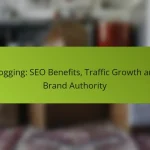Blogging is a powerful tool for enhancing SEO, driving traffic growth, and establishing brand authority. By consistently producing quality content, businesses can improve their website’s visibility, attract organic traffic, and position themselves as trusted sources in their industry. This not only boosts engagement but also fosters lasting relationships with audiences, ultimately elevating a brand’s online presence.

How can blogging improve SEO in the United States?
Blogging can significantly enhance SEO by increasing website visibility, improving keyword targeting, and optimizing site structure. These factors collectively drive more organic traffic and elevate a brand’s online presence.
Increased organic search visibility
Regularly publishing blog content helps improve organic search visibility by providing fresh, relevant material for search engines to index. This can lead to higher rankings in search results, making it easier for potential customers to discover your website.
To maximize visibility, focus on creating high-quality, informative content that addresses common questions or needs within your industry. Aim for a consistent posting schedule to keep content fresh and engaging.
Enhanced keyword targeting
Blogging allows for strategic keyword targeting, which is essential for attracting the right audience. By incorporating relevant keywords and phrases into your blog posts, you can better align your content with what users are searching for.
Consider using tools like Google Keyword Planner to identify popular search terms related to your niche. Aim to include a mix of short-tail and long-tail keywords to capture a broader audience while also targeting specific queries.
Improved site structure and internal linking
A well-structured blog enhances site navigation and user experience, which are important factors for SEO. By organizing content into categories and using internal links, you can guide visitors through your site and keep them engaged longer.
Implement a clear hierarchy in your blog, using categories and tags effectively. Additionally, link to relevant blog posts within your content to create a web of interconnected articles, which can help search engines understand the context and relevance of your site.

What traffic growth can be expected from blogging?
Blogging can significantly enhance traffic growth, often leading to increased visibility and engagement over time. By consistently producing quality content, businesses can attract a larger audience through organic search and social media channels.
Higher website traffic from search engines
Blogging boosts website traffic primarily through improved search engine optimization (SEO). Each blog post serves as an opportunity to rank for specific keywords, making it easier for potential customers to find your site. Regularly updated content signals to search engines that your website is active, which can lead to higher rankings.
To maximize this benefit, focus on keyword research and incorporate relevant terms naturally into your posts. Aim for a mix of short-tail and long-tail keywords to capture different search intents.
Increased referral traffic from social media
Sharing blog posts on social media platforms can drive significant referral traffic to your website. Engaging content encourages users to share your posts, expanding your reach and attracting new visitors. Platforms like Facebook, Twitter, and LinkedIn can be effective channels for promoting your blog content.
To enhance social media traffic, create eye-catching headlines and visuals that encourage clicks. Regularly interact with your audience to build a community around your brand, which can lead to more shares and referrals.
Long-term traffic sustainability
Blogging contributes to long-term traffic sustainability by creating a repository of content that continues to attract visitors over time. Older posts can still generate traffic if they remain relevant and optimized for search engines. This compounding effect can lead to a steady stream of visitors, even from content published months or years ago.
To maintain this sustainability, regularly update older posts with fresh information and ensure all links are functional. Consider creating a content calendar to plan new posts while revisiting and refreshing existing content periodically.

How does blogging establish brand authority?
Blogging establishes brand authority by showcasing knowledge and expertise in a specific field, which helps to position a brand as a trusted source of information. Through consistent, high-quality content, brands can build credibility and foster relationships with their audience.
Demonstrates expertise in niche
By regularly publishing insightful articles, a blog allows brands to demonstrate their expertise within a particular niche. This can include sharing industry trends, providing how-to guides, or offering in-depth analyses of relevant topics. Over time, this expertise can differentiate a brand from competitors.
For instance, a tech company that blogs about the latest software developments can establish itself as a thought leader, attracting an audience that seeks reliable information and solutions. This not only enhances brand authority but also encourages repeat visits from readers.
Builds trust with audience
Trust is a crucial component of brand authority, and blogging helps cultivate this trust through transparency and authenticity. By sharing personal stories, case studies, or customer testimonials, brands can connect with their audience on a deeper level.
Consistent, honest communication fosters a sense of reliability. For example, a health and wellness brand that shares evidence-based articles and openly discusses its product sourcing can reassure consumers about its commitment to quality and ethics.
Encourages audience engagement
Engaging content encourages audience interaction, which further solidifies brand authority. Blogs can include comment sections, polls, or social media sharing options that invite readers to participate in discussions or share their opinions.
For example, a fashion brand might post style tips and ask readers to share their own looks, creating a community around the brand. This engagement not only builds loyalty but also provides valuable feedback that can inform future content and product offerings.

What are the prerequisites for successful blogging?
Successful blogging requires a clear understanding of your target audience and a well-defined content strategy. These elements are essential for creating engaging content that attracts readers and builds a loyal following.
Identifying target audience
Identifying your target audience is crucial for tailoring your blog content to meet their needs and interests. Start by defining demographics such as age, gender, location, and interests to create a clear picture of who your readers are.
Utilize tools like Google Analytics and social media insights to gather data about your audience’s behavior and preferences. This information can guide your content creation, ensuring it resonates with your readers and encourages engagement.
Creating a content strategy
A solid content strategy outlines the types of content you will produce, the frequency of posting, and the channels for distribution. Begin by setting clear goals, such as increasing traffic or enhancing brand authority, to shape your strategy effectively.
Consider creating an editorial calendar to plan topics and publication dates. This helps maintain consistency and allows you to align your content with seasonal trends or relevant events in your industry.

Which metrics should be monitored for blogging success?
To gauge blogging success, focus on key metrics that reflect traffic, engagement, and conversions. Monitoring these indicators helps identify strengths and areas for improvement in your blogging strategy.
Organic traffic growth
Organic traffic growth measures the number of visitors arriving at your blog through search engines without paid advertising. Tracking this metric over time can reveal the effectiveness of your SEO efforts and content quality.
Use tools like Google Analytics to monitor organic traffic trends. Aim for steady growth, ideally in the double digits percentage-wise month-over-month, which indicates that your content is resonating with readers and ranking well in search results.
Engagement metrics (comments, shares)
Engagement metrics, such as comments and shares, indicate how well your audience interacts with your content. High engagement suggests that your posts are valuable and relevant to readers.
Monitor the number of comments and social shares for each post. A good benchmark is to aim for at least a few comments and shares per article, which can enhance visibility and encourage community building around your blog.
Conversion rates from blog visitors
Conversion rates from blog visitors measure how effectively your blog turns readers into leads or customers. This metric is crucial for understanding the ROI of your blogging efforts.
To calculate conversion rates, divide the number of conversions by the total number of visitors and multiply by 100. A typical conversion rate for blogs can range from 1% to 5%, depending on your industry and the quality of your calls to action. Focus on optimizing your content and CTAs to improve this rate.

What are common blogging mistakes to avoid?
Avoiding common blogging mistakes is crucial for maintaining reader engagement and improving SEO. Key errors include neglecting audience research, inconsistent posting schedules, and failing to optimize content for search engines.
Neglecting audience research
Understanding your audience is essential for creating relevant content. Failing to conduct audience research can lead to topics that don’t resonate, resulting in low engagement. Use tools like surveys or social media polls to gather insights about your readers’ interests and preferences.
Inconsistent posting schedule
Inconsistency in posting can confuse your audience and harm your blog’s credibility. Establish a regular posting schedule that you can realistically maintain, whether it’s weekly, bi-weekly, or monthly. Consistency helps build a loyal readership and improves your blog’s visibility in search results.
Ignoring SEO best practices
Neglecting SEO can limit your blog’s reach and traffic growth. Ensure you use relevant keywords, optimize meta tags, and include internal and external links. Regularly update older posts to keep them relevant and improve their search rankings.
Overlooking mobile optimization
With a significant portion of web traffic coming from mobile devices, failing to optimize for mobile can alienate a large audience. Use responsive design to ensure your blog looks good and functions well on all devices. Test your site on various screen sizes to identify and fix any issues.
Not engaging with readers
Ignoring reader comments and feedback can hinder community building. Engage with your audience by responding to comments and encouraging discussions. This interaction not only fosters loyalty but can also provide valuable insights for future content.









